Porcelain Insulator News
by Elton Gish
Reprinted from "Crown Jewels of the Wire", February 2005, page 10
I've been doing a lot of patent searches trying to find all insulator related
patents. With the internet, this has become much easier. The list now contains
around 2000 patents. I thought I would share with you two patents that explain a
mystery with two different insulators and a few that are very interesting. If
anyone is looking for a particular insulator patent, most likely I have it in
the files of the Insulator Research Service (IRS).
The first insulator was a total mystery for about 20 years. People were
always asking about it and no one could ever explain what it was used for.
Finally, in late 1987, someone solved the mystery. Marion Oschman wrote me to
explain how it was used. It was a stand off insulator mounted on the back wall
of a neon sign. The insulator held a square copper conductor in the transformer
terminals with the other end securing the end of the neon tube. The four notches
in the base of the insulator was where metal clips held the insulator in place.
Marion even sent me one of the insulators complete with metal conductor and metal
tip of the neon tube still attached.
As you can see in the next two pages from patent No. 2,173,510 (Sept. 19,
1939), the insulator can support either one or two square conductors to provide
current for individual neon tubes. I believe the insulators were discontinued
when neon signs were made cheaper by using one continuous tube and coating the
interconnecting length of tube between the letters or numbers with an opaque
paint.
The next patent deals with multipart porcelain insulators M-2322, M-3462, and
M-4360 (photos page 13). These insulators have a "wire groove" at the
bottom of the skirt with a notch cut out on opposite sides. It is an odd feature
that no other insulator has. No one could explain it and it was not specific to
one manufacturer. In fact, specimens of M-2322 have been found made by Locke and
Lapp (3 of each reported and one unmarked); M-3462 made by Lapp (only 1
reported), and M-4360 made by Pittsburg HV (only 1 reported and another damaged
specimen). Another interesting feature is all of the specimens known except one
N-N M-2322 and the M-3462 have a cobalt blue glaze!
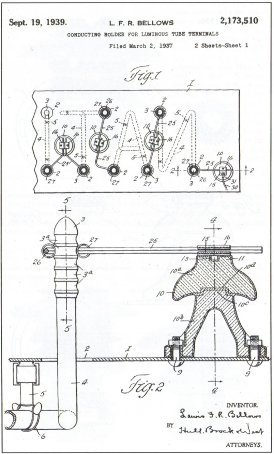
Medium Image (83 Kb)
Large Image (237 Kb)
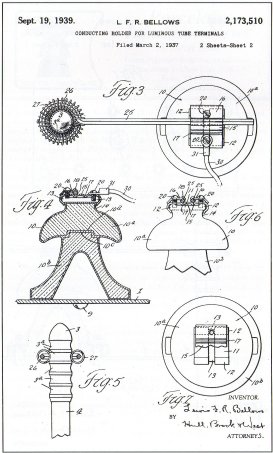
Medium Image (89 Kb)
Large Image (253 Kb)
Patent No. 1,574,964 (March 2,1926) covers this unique design. The patent was assigned to Electrical Engineers Equipment Co. in Chicago. You may ask
how could Pittsburg HV produce an insulator that late? Notice the patent
application was filed in 1918, well before Westinghouse took them over in 1921.
As you can see from the patent drawing, the groove around the bottom of the
skirt was intended for a metal bracket. The two notches in the bottom edge of
the skirt was for a special metal bracket to fit in, which offered additional
support against horizontal strain and prevented the insulator from turning. The
entire design was to provide a strong insulator for heavy weight loads and
horizontal strains. The only brackets I have seen were on a cobalt blue M-2322.
It did not have a bracket attached to the groove at the bottom, but rather a
three-legged metal base with the steel pipe pin (cemented in the insulator)
threaded into the center of it. Another patent, No. 1,663,007 (March 20,1982)
shows a different style top and bottom bracket. This patent is also assigned to
EEECo.

In the mid-1930's, Ohio Brass was certain they could solve the problems with
high voltage insulator in foggy areas. They obtained two patents for suspension
insulators that are quire bizarre. You can well image the difficulty to
manufacture them.
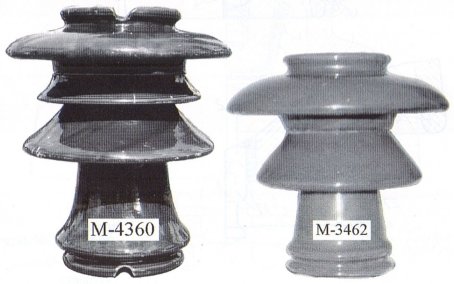
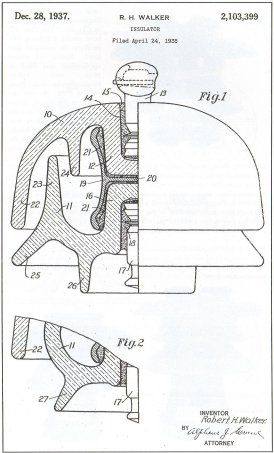
Medium Image (77 Kb)
Large Image (238 Kb)
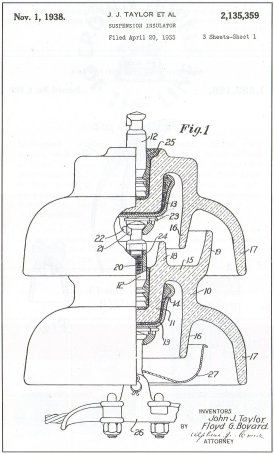
Medium Image (72 Kb)
Large Image (212 Kb)
The last patent is very odd indeed. It calls for making insulators from cow's
horn. The patent is No. 1,333,188 (March 9,1920) and granted to a person in Vercelli,
Italy.
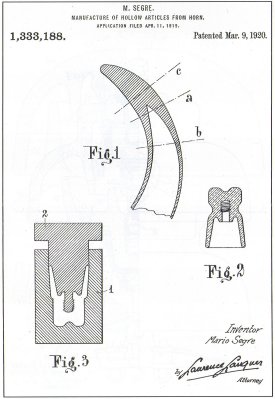
Medium Image (59 Kb)
Large Image (174 Kb)
| 